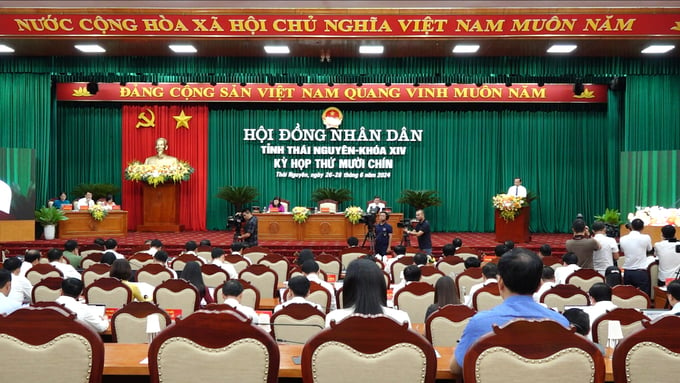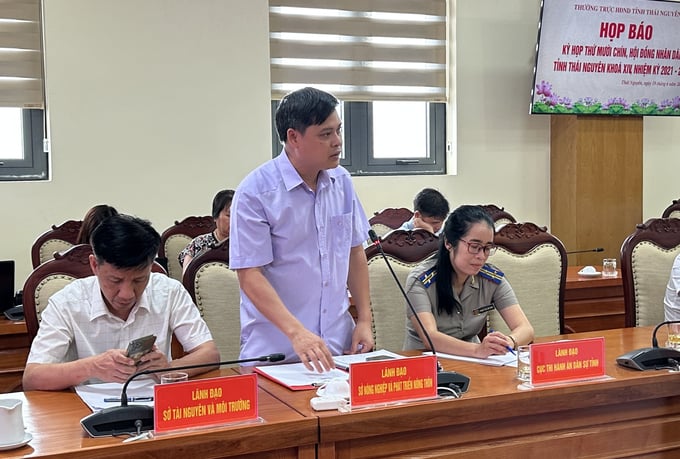December 13, 2025 | 07:50 GMT +7
December 13, 2025 | 07:50 GMT +7
Hotline: 0913.378.918
December 13, 2025 | 07:50 GMT +7
Hotline: 0913.378.918

19th session, Thai Nguyen Provincial People's Council term XIV, June 26. Photo: Quang Linh.
According to the Report on the socio-economic situation in the first 6 months of the year and key tasks in the last 6 months of 2024 of Thai Nguyen Provincial People's Committee at the 19th Meeting, Thai Nguyen Provincial People's Council Term XIV, the gross Regional Domestic Product (GRDP) in the province is estimated at 6.03%.
Of which, the agriculture, forestry, and fishery sectors increased by 3.71% with an estimated production value of VND 8,406 billion, up 3.75% over the same period.
In addition, the industrial and construction sector recorded a growth rate of 5.99%; the service sector increased by 7.19%; Product tax minus product subsidies increased by 5.02%. Budget revenue is estimated at VND 9,228 billion, up 19.6% over the same period.
In 2024, the Thai Nguyen province plans to plant new and replant 395 hectares of tea. The area of new and replanted tea is estimated to reach 106 hectares. Fresh tea bud output in the first 6 months of the year is estimated at 118.6 thousand tons, up 3.5% over the same period.
Faced with the complicated developments of animal diseases, especially African swine fever, districts and cities have proactively guided people to reorganize herds and prevent epidemics.
In the first 6 months of 2024, Thai Nguyen province recorded an outbreak of African swine fever in 15 households in 6 hamlets of Trang Xa commune, Vo Nhai district, with 25 infected and dead pigs destroyed.
Authorities and local agencies have immediately implemented epidemic prevention measures in the area. Vaccination work for livestock and poultry in the first phase 2024 has been accelerated. To date, 2.18 million doses of various types of vaccines have been administered.

Mr. Duong Van Hao, Deputy Director of the Department of Agriculture and Rural Development, provided information about preventing and controlling African swine fever at the 19th Meeting of the People's Council of Thai Nguyen province, term XIV. Photo: Quang Linh.
According to Mr. Duong Van Hao, Deputy Director of Thai Nguyen Department of Agriculture and Rural Development, African swine fever has recently occurred in some areas of the province. The agricultural sector has implemented solutions and forces to regularly monitor African swine fever developments in neighboring localities to strengthen control of animal transportation activities.
The Department of Agriculture and Rural Development also proposed establishing a mobile team to disinfect and destroy infected pigs as well as assigning specialized staff from the Department to support localities in handling the epidemic.
Currently, the total herd of buffaloes and cows reaches 95 thousand, 600 thousand pigs, 16 million poultry flocks. Live-weight meat output in the first 6 months of 2024 is estimated to be 120 thousand tons, up 7.8% over the same period.
The People's Committee of Thai Nguyen province also recommends that localities continue to pay attention to developing livestock farming in the direction of concentrating farm sizes, applying scientific and technological advances in high-yield breeds, cold barns, and feed operations automation, drinking water, environmental treatment and building value chains in livestock farming.
In 2024, Thai Nguyen province sets great expectations with an ambitious economic growth target of 7.5%. Through the first 6 months of 2024, strong growth in GRDP was recorded due to the growth rate of total products in Agriculture, forestry, and fisheries; Industry and construction; services and tourism... Thai Nguyen has identified and implemented a series of critical tasks and specific solutions to achieve that growth goal.
Thai Nguyen province will continue to attract investment in advanced technology projects that are environmentally friendly and efficient in resource use. This not only helps enhance business innovation and competitiveness but also promotes the province's sustainable development.
In addition, applying science and technology to agricultural production will improve productivity and product quality while helping the province access and develop new markets. Diversifying tourism products and improving service quality will not only attract tourists but also contribute to promoting the image and culture of Thai Nguyen to the world.
Thai Nguyen province focuses on improving the quality of education, training, and health care, which are essential factors in socio-economic development. Reducing the poverty rate is also one of the top goals, contributing to building a fair society and comprehensive development.
With strong determination and support from both the political system and the people, Thai Nguyen is getting closer to realizing its economic growth goals. The province is committed to continuing administrative reform and creating favorable conditions for investment, thereby promoting comprehensive socio-economic development.
Translated by Huong Giang

(VAN) On December 12, the Ministry of Agriculture and Environment organizes the Forum 'Sustainable Development of Vietnam's Marine Economy by 2025'.

(VAN) International partners acknowledge Viet Nam’s strong progress in improving the legal framework and raising its emission-reduction commitments.

(VAN) Researchers from Penn State University believe drones could not only enhance turkey welfare but also save producers money on costly, time-consuming, and labour-intensive checks.

(VAN) The Sustainable Agricultural and Forestry Production Development Support Project in Angola is key to both advancing sustainable development and guaranteeing national food security.

(VAN) According to Deputy Minister Nam, women are as capable as anyone when granted the opportunity to experiment and innovate.

(VAN) Dr. Fred Unger, former Regional Representative of ILRI in Asia, is honored as a pioneering expert who helped establish Viet Nam’s One Health and risk-based approaches in food safety.

(VAN) By joining the carbon market, Hoang Lien National Park can reinvest revenues into conservation and improving community livelihoods.